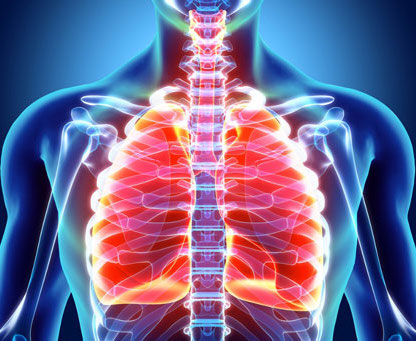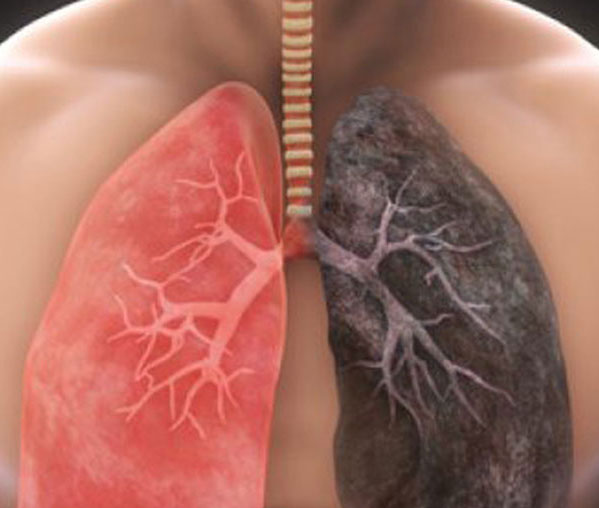Large group of lung diseases that cause scarring (fibrosis) of the lungs comes under the umbrella of interstitial lung diseases (ILD). The scarring causes the inflammation which leads to more than 200 different conditions of the lungs damaging the balloon like air sacs in the lungs known as alveoli.
Oxygen travels into the bloodstream through alveoli but once it is scarred it can’t expand properly decreasing the amount of oxygen in the bloodstream. Usually the scarring of the lungs is irreversible and might worsen with time; medication may slow down the damage. However, some people might not regain the full capacity of the lungs.

Adults as well as children are affected by ILD. The symptoms can range from mild to severe which affect the average survival from 3 to 5 years. The survival can be increased with appropriate medication. Some types of interstitial disease are:
- Idiopathic pulmonary fibrosis – It is a chronic and progressive lung disease which causes scar tissues or fibrosis to develop in the lungs causing the decrease in the oxygen transport in the bloodstream. The reason for the fibrosis is yet unknown but it might worsen with time and cause difficulty to breath. In acute conditions it is referred to as Acute interstitial pneumonitis or Hamman-Rich syndrome. This happens suddenly and sometimes to healthy individuals.
- Interstitial pneumonia – It is caused by the bacterial, fungal or viral infection by affecting the interstitium. Most commonly caused by Mycoplasma pneumonia which is a bacteria.
- Nonspecific interstitial pneumonitis – It is a rare disorder of the alveoli affecting people with autoimmune disease. It occurs mainly in women, non-smokers or patients above 50 years of age.
Healthy Lungs - Hypersensitivity pneumonitis – This is caused by dust, mold, or other things that we breathe and these pollutants irritate the lungs over a long period of time.
- Asbestosis – This is caused by inhaling asbestos, a fiber used in building materials; which causes inflammation and scarring of the lungs. It can also lead to cancer, mesothelioma and pulmonary heart disease.
- Sarcoidosis – It is an inflammatory disease which results in swollen lymph nodes making it difficult to provide oxygen to the bloodstream. It can also affect various organs like heart, skin, nerves, and eyes.
SYMPTOMS OF INTERSTITIAL LUNG DISEASE:
Most common symptom of interstitial lung disease is shortness of breath even at rest which aggravates due to exertion. People might also experience dry cough, chest discomfort, fatigue and sometimes weight loss. Symptoms often appear late thus causing irreversible lung damage.
One should visit the doctor the first time they feel shortness of breath even at rest. Cases that are severe should not be left untreated as they might develop life-threatening complications like high blood pressure or even heart or respiratory failure
WHAT CAUSES INTERSTITIAL LUNG DISEASE?
Cause for some of the interstitial lung diseases are yet unknown. Some are caused by bacteria, fungi or viruses. Whereas, some are caused by pollutants like asbestos, coal dust or other metal dusts, silica dust, talc and grain dust. Rarely, antibiotics (like nitrofurantoin), anti-inflammatory drugs (like rituximab), heart medication (like amiodarone) and chemotherapy drugs (like bleomycin) can cause interstitial lung disease.
Doctors recommend chest X-ray or CT scan to know initially the extent of the damage to the lungs. If doctors are skeptical about interstitial lung disease they would recommend High-resolution CT scan to get better-quality images of the interstitium as well as lung function test to measure the total capacity of the lungs.
Stress tests help determine breathing symptoms due to heart or lung disorder. It is determined by increasing the work of the heart as the person exercises on the treadmill or takes medication that increases the heart rate. Bronchoscopy and lung biopsy are invasive procedures that help determine the type of interstitial lung disease by removing the small bit of the lung tissue.

TREATMENT OPTIONS FOR INTERSTITIAL LUNG DISEASE
Interstitial lung disease cannot be reversed completely as it is progressive. Some of the treatment may slow down the progression of the scarring of the lung tissue that helps the patient to breathe more comfortably. The treatment of interstitial lung disease depends on the type of ILD diagnosed and its severity.
If interstitial lung disease is caused by the toxic pollutants then it is important to avoid them and take proper treatment to slow down the damage which is caused.
Healthcare providers would combine medications as well as therapy for better results.
- Antibiotics – Used in mostly all types of interstitial pneumonias. If the pneumonia is caused by viruses they get better with time but fungal pneumonias are rare and need to be treated with antifungal drugs. Some commonly used antibiotics are nitrofurantoin (Macrobid, Macrodantin) and sulfasalazine (Azulfidine).
- Supplemental oxygen therapy – It is recommended as per international guidelines. This has proven to provide benefit in interstitial lung disease as patients feel less breathless after its use. Regularly inhaling pure oxygen will help protect the heart from damage due to low oxygen level in blood. Oxygen can be provided in different ways like nasal cannula, face mask and inside a hyperbaric chamber. Oxygen is available in gas form or liquid form which are both portable. Hence, patients who require long-term use of oxygen therapy can be provided oxygen concentrators at the ease of their home. In hyperbaric oxygen therapy people will breathe pure oxygen in a pressurized room or chamber with air pressure increased 3 or 4 times than the normal pressure level in air. It helps in breathing with ease, increases stamina and increases expectancy of life.
- Anti-inflammatory drugs – Corticosteroids like aspirin, etanercept (Enbrel), and infliximab (Remicade) help in reducing the inflammation in the lungs which causes damage and scarring to the lungs. These might cause the immune system’s activity to slow down but lessen the inflammation and provide rest to the body.
Diseased Lungs - Immune suppressing drugs – In case of auto-immune interstitial lung disease, doctors prescribe immune suppressing drugs to reduce the damage occurring to the lungs. These drugs like azathioprine (Imuran), mycophenolate mofetil (CellCept) and cyclophosphamide (Cytoxan) help stop the body’s own immune system to damage the lungs.
- Anti-scarring drugs – These drugs block the pathway that is necessary to cause scarring tissue formation in the lungs especially in case of idiopathic interstitial lung disease. Drugs like Ofev (nintedanib) and Esbriet (pirfenidone) are found to be effective in reducing scarring as per recent studies.
- Lung transplant – In case of severe and progressive conditions transplantation would be required. It is important that the donor should be free from other health issues and lung capacity should be good enough. This is not a cure but usually a last resort in case of severe conditions.
Doctors may combine one or more treatments for better results but they might affect the immune system. It is important to eat a high nutrient diet as these medications have serious side effects.
OUTLOOK
Interstitial Lung Disease is a progressive disease which currently has no cure for the damage and the scarring caused to the lungs. Symptoms may differ from people to people and the damage might not be completely reversed. Treatment like oxygen therapy, pulmonary rehabilitation, and healthy lifestyle help in managing the disease and providing better life expectancy.
If you or anyone you know is suffering from Interstitial Lung Disease, our expert providers at Specialty Care Clinics will take care of your health and help you recover.
Call us on 469-545-9983 to book an appointment with Dr. Badar Kanwar.
